Rid your home of unwanted pests with guaranteed service from Eagle Pest Control.
Eagle’s pest control maintenance service is designed to keep you home pest-free by creating a protective barrier around the exterior of your home. We use extremely effective, long-lasting products that are safe to use in homes, schools, day cares, and food service establishments. Our full-service maintenance plans are inclusive of all general household pests. You will have a pest-free environment, both inside and outside of your home or business – Guaranteed.For Service calls and pricing, please call 502-243-1600
Spiders
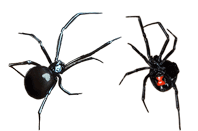
Black Widow Spider
Black widows are named for the female's occasional cannibalistic practice towards her mate. Females are easier to identify, and sometimes males aren't even recognized as black widows. Males are smaller, and lighter in color. However, females are the only sex able to inflict the painful bite. Females are dark colored, around ½" long, with a bulbous abdomen.
Luckily they have a red hourglass on their underside, which is made visible by the female's habit of hanging upside down from her web. Black widow populations are erratic, sometimes rising and falling dramatically over the years.
They prefer to make their webs in dark, dry, undisturbed places. They are common underneath houses, in garages, or outside in woodpiles. Black widow webs are very irregular in design, not looking like the traditional bulls eye shape. Females can get defensive around their webs and bite, especially when there are egg sacs present.
The venomous bite from one of these spiders causes pain rather quickly. If a black widow bite is suspected, look for the two small teeth marks on the swollen area. Although 99% of people survive the bites, it is still a good idea to contact your doctor - especially if a young child, or older person is involved. Watch out for signs like nausea, tremors, and sweating if bitten. First aid such as washing the area and applying ice can provide minor relief.
To keep from getting bitten wear gloves when working in areas that could have spiders, and pay attention. Look for irregular webs, egg sacs, and spiders. Removing webs, and crushing spiders and egg sacs is helpful in controlling overall black widow populations.
Fogging for black widow spiders is particularly effective for knockdown, because they spend most of their time on their web. Residual sprays have to contact them directly, since they may not crawl through them.
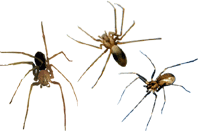
Brown Recluse
The brown recluse is also sometimes called the violin spider, or the fiddleback. It gets its common names from its solitary behavior, and markings that sometimes resemble a violin. Their coloration can be various shades of brown or tan. These spiders are under ½" long, and both males and females can bite.
The recluse likes to live in similar places as the black widow; undisturbed areas like crawl spaces, attics, or in storage containers. But can also be found in household items like clothes, shoes, or cabinets that have gone undisturbed for a while. Similar to the black widow is their irregularly shaped web, but the recluse uses their web for a home rather than catching prey.
To catch another insect for food, the recluse comes out of its web at night and roams around until it finds one. This behavior leads to a higher risk of finding them in beds or other areas where people are likely to run into them.
Brown recluses' have a nasty bite, which isn't always felt right away. If you suspect one has bitten you, contact a doctor. Recluse venom causes swelling, lesions, and flesh deterioration that can take a long time to heal. Other physical symptoms include dizziness, nausea, and joint pain.
In areas where recluses are present, it's a good idea to keep beds in the open, with no ruffle touching the floor. Clothing and shoes should also be kept off the floor, and shaken out before wearing.
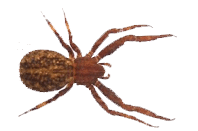
Crab Spider
There are several types of spiders that are commonly called "crab spiders." Most of the common Crab Spiders found in Kentucky are in the family Thomisidae. They tend to have a flat shape compared to other spiders, and their front 2 pairs of legs are typically very long compared to the back 2 pairs. Thomisid crab spiders hold their front legs out and up, like the way a crab holds its claws. Many thomisid crab spiders have bright, "neon" colors like yellow, green, and orange. Others are dark colored with gray and brown patterns.
Running Crab Spiders belong to the family Philodromidae. They tend to be less colorful than crab spiders in the family Thomisidae. All crab spiders have 8 eyes. Like all spiders, crab spiders have 8 legs, 2 body parts, and fang-like mouthparts called "chelicerae."
Like all spiders, crab spiders go through a simple metamorphosis. Young crab spiders hatch from eggs and look like tiny adults. They shed their skin as they grow. Most crab spiders live for less than 1 year. Female produce hundreds of eggs in the fall, and the offspring hatch in the spring.
Most crab spiders and running crab spiders do not use silk to capture prey. Instead, they are ambush predators: they wait motionless on flowers, leaves, and other strategic spots for flies, bees, and other prey. Many crab spider species, especially in the family Thomisidae, have the same bright colors of the flowers on which they sit. Others have drab colors that camouflage well with bark or soil. Crab spiders are able to walk forwards, backwards, and sideways with ease.
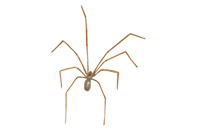
Daddy Longleg (Cellar Spider)
The cellar spider, or daddy longlegs is a group of many different species. They are named for their frequent appearance in cellars or their disproportionately long legs. Daddy longlegs' cause no harm to people, and are actually predators of many other pests in the home.
The webs they spin in the corner of the home can be a nuisance, and build up more rapidly than other spiders - which warrants control. Typically you will see them hanging upside down from their webs. When disturbed, this spider will vibrate quickly on its web.
A combination of their thin bodies and vibrating behavior will cause them to look like a blur.
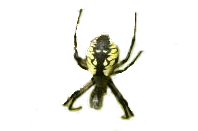
Garden Spider (Black and Yellow)
One of largest spiders is an orb weaver called the Black and Yellow Argiope, Argiope aurantia, pictured below. Commonly called "garden spiders," these orb weavers can be almost 3 inches long from leg tip to leg tip. Argiope spiders are very common in backyard gardens, and have given a fright to many a homeowner. Although they are large and intimidating, their bite is only dangerous to people who experience severe allergic reactions to insect and spider bites.
Argiope spiders are also called "writing spiders" because of the bold zigzag pattern that they build into their web.
As is true in many spider species, females of this species grow to much larger size than males. Adult female body length ranges from 19 to 28 mm (3/4 to 1 1/8 in.), while males reach only 5 to 9 mm (1/4 - 3/8 in.). In both sexes, the shiny, egg-shaped abdomen has striking yellow or orange markings on a black background. The forward part of the body, the cephalothorax, is covered with short, silvery hairs. Legs are mostly black, with red or yellow portions near the body.
In areas with a cold winter, the eggs of this species hatch in the late summer or autumn, but the hatchling spiders become dormant and do not leave the egg sack until the following spring. Hatchlings generally resemble small adults, there are no major changes in anatomy or structure as they grow (except the development of reproductive organs).
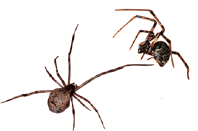
House Spider
The house spider is named for its common occurrence in and around houses. They are less than ¼" long, and can be many variations of colors. While it is true that house spiders are helpful to control other more bothersome pests, they can be a nuisance themselves. If a web doesn't yield a spider many insects, they will abandon it and build another. This can lead to a large accumulation of spider webs, which are sticky and difficult to clean up.
People seldom get bit from these spiders, and the bites are not very harmful.
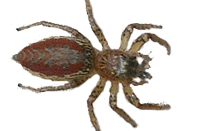
Jumping Spider
Jumping Spiders may be the easiest to recognize. Jumping spiders have a very distinctive, flat-faced, big-eyed appearance that is difficult to confuse with other kinds of spiders. They also have a unique, herky-jerky way of moving. Most are small and hairy. Like all spiders, jumping spiders have 8 legs, 2 body parts, and no antennae. Eight eyes are present on jumping spiders, although 1 pair is often so small that it appears as though there are only 6 eyes. One pair of eyes is always very large and directed forward, almost like human eyes.
Simple metamorphosis: like all spiders, young jumping spiders hatch from eggs and look like tiny adults. They shed their skin as they grow. Many female jumping spiders construct a silk case for their eggs and guard them until they hatch. The egg case is often built off of the ground in leaves, on branches, or in crevices on the sides of buildings.
Jumping spiders are fast-moving, active hunters. Because they are excellent climbers and jumpers, they are able to search for prey in many different locations. Some hunt on the ground, while others search tree trunks and plants for prey. Many are also common on man-made structures like fence posts and the sides of buildings. Jumping spiders are also especially common in barns and sheds.
Jumping spiders are not normally pests, but they often wander into homes. They can bite, but they are not considered dangerous. Because they sometimes get into homes, jumping spiders are occasionally confused with the dangerous brown recluse spider.
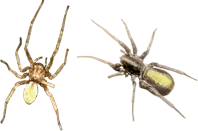
Sac Spider
Sac spiders are named for the silk tubes they build for their homes. These sacks can be seen in foliage, on the ground, or in parts of the house - and are unique from other spiders. Sac spiders are up to 3/8" long, and range in color from yellow-green to orange-brown.
Since sac spiders roam about the house on walls and ceilings at night, they have more potential to end up biting humans. Typically people get bitten when these spiders get into clothes or in beds. In fact, most spider bites that are received inside are from these spiders. Bites are occasionally confused with that of a recluse, but are not nearly as bad and don't always form a lesion.
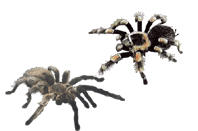
Tarantula
Tarantulas are the largest and hairiest of spiders. Their body length is around 2"-3" and their leg span around 5". Coloration can be from tan to dark brown with various colored markings. They are probably more common as pets, than as pests in this area. They spend most of their time hiding in places like burrows, and are nocturnal. However, males venture out looking for mates - making them more common to be seen.
Tarantulas can live up to 20 years, and can go very long periods of time without eating. Possessing hairs with tiny barbs on them, the tarantula will sometimes use them for defense. These hairs can be very irritating to humans, and cause allergic reactions. They also have a slightly poisonous bite, which is compared to a bee sting.
On occasion they can wander into a house through an open door, but aren't considered to be hostile. They can be transplanted elsewhere to help control other insects.
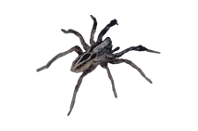
Wolf Spider
Wolf spiders are named for the way that they sometimes chase down prey when hunting. But are also wolf-like in appearance with a relatively large size, and hairy body. They range in size from ¼" up to 1" or more in length.
Depending on the species, coloration is brown with gray, white, yellow, or black markings. With 8 eyes, this spider can see very well to the front and back simultaneously - an adaptation for hunting insects. Primarily an outdoor dweller, the wolf spider lives under rocks or builds burrows in the ground.
Even though they have the ability to make webs, they rarely do, and they don't do so to catch prey. These spiders do make it into the house sometimes, and can be fairly intimidating. They move very quickly, and are sometimes confused with the recluse.
But they lack the telltale fiddle marking, and aren't poisonous. Bites from the wolf spider cause a swelling and itching reaction similar to other non-poisonous spiders, but it's uncommon for them to bite.
Additional resources are available to assist you in identifying and controlling insects.
Insect Identification
With over 1 million identified species of insects and spiders in the world with many more still awaiting discovery. Use Insect Identification categories to discover your species.
Pest World
For expert pest control tips and resources surf to Pest World.
Pest World for Kids
For fun pest facts and kid-friendly bug and insect research, head to Pest World for Kids.
